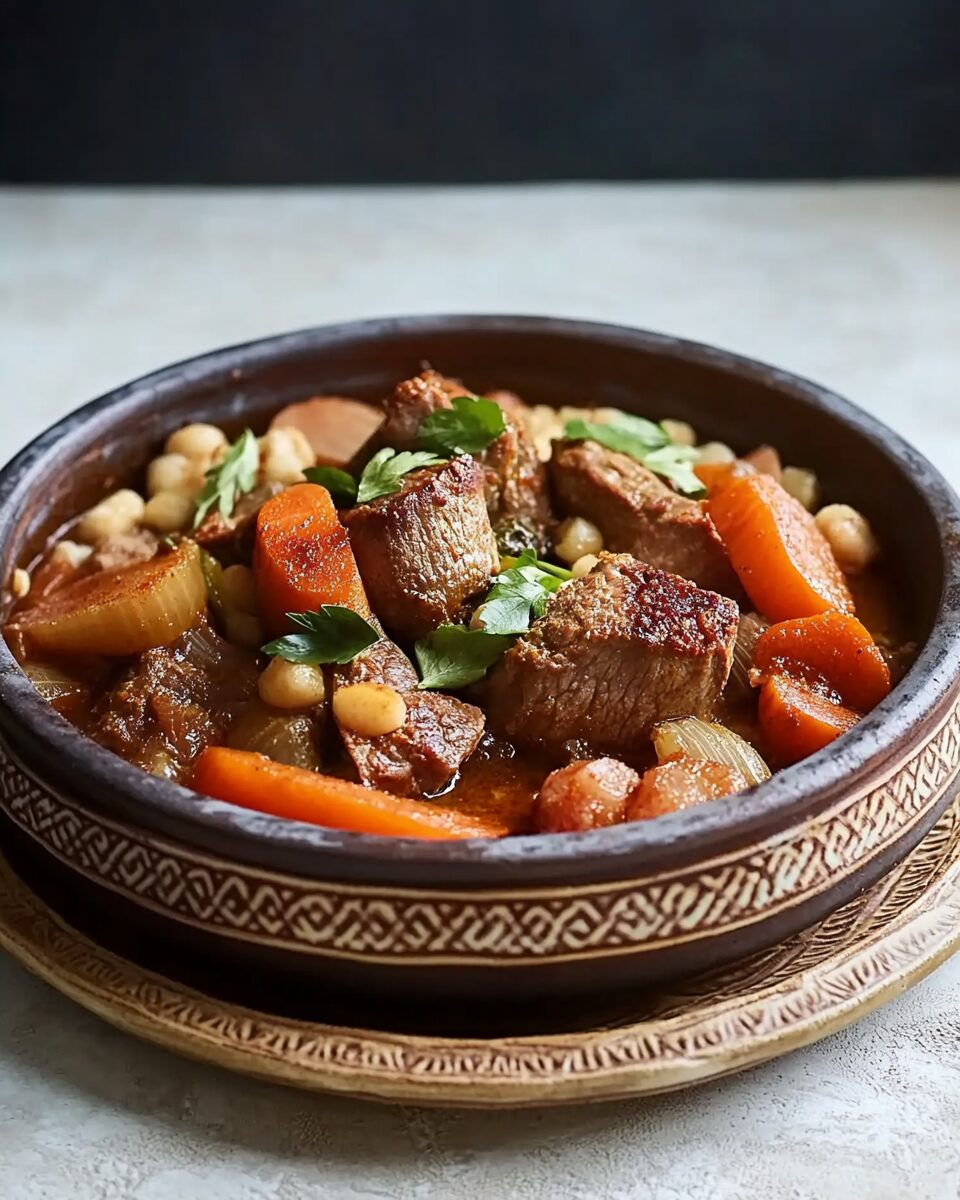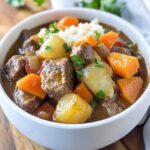Lamb Tagine is a rich and flavorful Moroccan stew, combining tender lamb with aromatic spices like cinnamon, cumin, and ginger. The dish is traditionally slow-cooked in a tagine pot, but can be made in a regular pot. It’s served with couscous or bread to soak up the savory sauce.
Full Recipe:
Ingredients
- 2 tablespoons olive oil
- 2 pounds boneless lamb shoulder, cut into 1-inch cubes
- 1 onion, chopped
- 2 cloves garlic, minced
- 1 teaspoon ground cumin
- 1 teaspoon ground ginger
- 1 teaspoon ground cinnamon
- 1/2 teaspoon ground turmeric
- 1/2 teaspoon ground black pepper
- 1/4 teaspoon ground cayenne pepper (optional)
- 1 cup chicken broth
- 1 can (14.5 ounces) diced tomatoes, drained
- 1/2 cup dried apricots, chopped
- 1/4 cup honey
- 1 tablespoon chopped fresh cilantro
- Salt to taste
Directions
- Heat olive oil in a large pot over medium-high heat. Add lamb cubes and brown them on all sides, about 5-7 minutes. Remove the lamb and set aside.
- In the same pot, add chopped onion and garlic, cooking until softened, about 3 minutes.
- Stir in cumin, ginger, cinnamon, turmeric, black pepper, and cayenne pepper. Cook for another 1-2 minutes until fragrant.
- Return lamb to the pot, add chicken broth, diced tomatoes, apricots, and honey. Stir to combine.
- Bring the mixture to a boil, then reduce the heat to low and cover. Simmer for 1.5 to 2 hours until the lamb is tender and the sauce has thickened.
- Garnish with fresh cilantro before serving.
Nutrients
- Calories: 380 kcal
- Protein: 30g
- Fat: 23g
- Carbohydrates: 21g
- Fiber: 4g
- Sugar: 18g
- Sodium: 400mg
The History and Cultural Significance of Tagine
The word “tagine” comes from the traditional North African cooking vessel, which is designed with a conical lid that helps circulate steam and keep the food moist. While lamb is often the meat of choice for a tagine, you can also find chicken, beef, or vegetarian versions of this dish, with each variety offering a slightly different flavor profile. Lamb Tagine is particularly beloved for its tender meat and fragrant spices. The origins of tagine date back centuries, and the dish has been passed down through generations, each adapting it with regional variations.
In Moroccan culture, meals are an essential part of the social experience. A typical Moroccan meal often features tagine as the centerpiece, accompanied by bread or couscous to help scoop up the stew. The slow-cooked nature of tagine makes it ideal for communal dining, where families and friends gather to share and enjoy the food together. The dish is often served with fresh herbs and sometimes a sprinkling of toasted almonds, providing added texture and flavor. The process of cooking lamb in a tagine enhances the natural flavors of the meat, creating a melt-in-your-mouth experience that is unique to this Moroccan specialty.
Flavors and Ingredients
The magic of Lamb Tagine lies in the combination of spices and ingredients that make up its unique flavor profile. Spices such as cumin, ginger, cinnamon, and turmeric form the backbone of the dish, offering warmth, earthiness, and a hint of sweetness. These spices are balanced by the tartness of dried apricots and the subtle sweetness of honey, making the dish both savory and slightly sweet.
Cinnamon is a key ingredient in Moroccan cooking and adds a fragrant depth to the dish. The combination of cinnamon and cumin brings a familiar yet exotic flavor that will transport your taste buds to the markets of Marrakesh. The lamb itself, when cooked properly, becomes extremely tender and absorbs the flavors of the spices and vegetables.
The use of dried fruits like apricots adds a touch of sweetness that balances out the more savory elements. Honey further enhances this sweetness, creating a beautiful harmony in the dish. Lamb Tagine is a perfect example of Moroccan cuisine’s use of complex flavor combinations, where sweet and savory ingredients come together to create a deliciously unique experience.
Cooking Techniques and Tips
The key to perfecting Lamb Tagine is using the right cooking techniques. Traditionally, this dish is made in a tagine pot, which helps create a steaming environment that cooks the lamb slowly and evenly. However, if you do not have a tagine pot, a Dutch oven or heavy-bottomed pot can also work well.
Slow cooking is essential for developing the deep, rich flavors in Lamb Tagine. The longer the stew simmers, the more tender the lamb becomes. The process also allows the spices to meld and intensify, resulting in a fragrant, flavorful dish. If you’re cooking it on the stovetop, be sure to keep the heat low and allow the dish to cook gently, so that the lamb retains its moisture and becomes incredibly tender.
Another important technique is to brown the lamb before cooking. This step helps seal in the flavors and creates a rich foundation for the dish. While the lamb is browning, the vegetables and spices are sautéed to bring out their aromas, which will infuse the dish with depth.
Pairing Lamb Tagine with Side Dishes
Lamb Tagine is typically served with couscous, a steamed grain that complements the rich sauce of the stew. The light, fluffy texture of couscous helps absorb the flavorful sauce, making it a perfect pairing for the tender lamb and spiced vegetables. In Morocco, tagine is often served with warm flatbread, which can be used to scoop up the stew, adding a delightful texture to each bite.
Another great accompaniment to Lamb Tagine is a fresh salad made with ingredients like tomatoes, cucumbers, and olives. This light and refreshing side dish helps balance the richness of the tagine. Additionally, a yogurt-based dip or raita can offer a cooling contrast to the warm and spicy flavors of the stew.
Nutritional Benefits of Lamb Tagine
Lamb Tagine is a flavorful dish that also offers nutritional benefits. Lamb is an excellent source of protein, which is essential for muscle growth and repair. It also contains important vitamins and minerals such as iron, zinc, and vitamin B12, which are vital for maintaining a healthy immune system and energy levels.
The addition of vegetables, such as onions, garlic, and tomatoes, boosts the fiber and vitamin content of the dish. Dried apricots are another healthy ingredient, offering dietary fiber, vitamin A, and antioxidants that help improve digestion and protect against free radicals.
While Lamb Tagine can be a relatively rich dish due to the use of olive oil and honey, it provides a well-rounded combination of protein, healthy fats, and complex carbohydrates. When served with couscous or bread, it becomes a satisfying meal that offers both energy and nutrition.
Variations of Lamb Tagine
Lamb Tagine is a versatile dish, and there are many variations that can be made based on your taste preferences or dietary needs. Some versions include nuts such as almonds or pistachios, which add crunch and texture. The sweetness of the apricots can be replaced with dates or prunes for a different flavor profile. In some variations, saffron is added for a subtle floral note, while others might incorporate olives for a briny contrast.
For those who prefer a spicier version, additional chili peppers or harissa (a North African chili paste) can be used to add heat. Vegetarians can also enjoy a tagine by using a variety of root vegetables, such as carrots, sweet potatoes, and parsnips, in place of meat. This makes the dish more accessible for those who avoid animal products while still maintaining the rich flavors and satisfying nature of the dish.
Conclusion
Lamb Tagine is more than just a dish; it’s a representation of Moroccan culture and the art of blending spices, herbs, and ingredients to create a harmonious meal. Whether enjoyed in the heart of Morocco or in the comfort of your own home, Lamb Tagine offers a rich, flavorful experience that highlights the beauty of slow-cooked meals.






